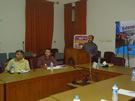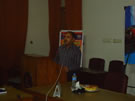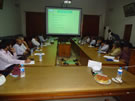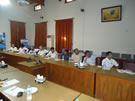The 24th Meeting of Dairy Club (Joint Venture of Alltech and UVAS) was held on Monday 3rd June 2013 at Syndicate Room UVAS.
Following was the agenda of meeting:
|
Title |
Speaker/Presenter |
Modern trends in silage making |
Lt. Col (R) Dr. Muhammad Arshad Shaad GM, Nutrition Resource Management PLDDB |
25 participants attended this meeting.
Dr. Ilyas opened the house and gave warm welcome to the participants. He explained the agenda.
Dr. Arshad presented his lecture in which he shared his experience of working with army and PLDDB. Bullet points of his presentation are as follows:
Fodder Production in Punjab
Need of silage
- Availability of fodder during scarcity period
- Uniform Feeding round the year
- Highly preserved nutrition resource
- Highly digestible forage
- Highly palatable forage
- More production
- Minimum Wastage
How to make the best silage?
- Selection of Fodder
- Crops Suitable for Silage Making
WHY CORN SILAGE?
- High Nutrition Value
- protein, starch, fat, 70% digestibility
- Required Water Soluble Carbohydrates
- Helpful in lowering pH
- High quality milk production than traditional fodders
Modern Trends in Silage Making
- Agronomic Practices
- Maize planter
- Flat sowing
- Higher plant population per acre
- Circular sowing
- Corn Hybrids
- Waxy corn - Different type of starch that can be more digestible than normal corn
- High Oil Corn - 3 to 4 percent more oil compared to normal corn hybrids
- High Lysine Corn - Higher levels of lysine, a limiting amino acid in dairy cow rations.
- Brown Mid-rib Corn: Half the normal lignin content of normal corn silage.
- Genetically Modified (GM) Corn
- Genetically improved
- Contain a gene or genes from the same or a different species artificially inserted in its genome.
- Purposes:
- To enhance nutritional quality
- To develop resistance against pests/insects
- BT Corn
- Bacillus thuringiensis - naturally-occurring soilborn bacterium
- Produces crystal-like proteins that selectively kill specific groups of insects.
- Crystal proteins (Cry proteins) - insect stomach poisons
- Insects stop feeding within two hours of a first bite and, if enough toxin is eaten, die within two or three days
- Environmentally sustainable way to control devastating insect pests
- Ensure maximum yield
- Better quality grains due to reduction in insect damage
- Significant economic return
- Provision of protection to non-Bt corn by reducing the overall population of corn borers
- Future of GM Corn
- Improved nutritional quality
- Improved feeding value
- Proven highly digestible hybrid
- Fermentation friendly
- Climate Adapted
- Weed control
- Long Stay green
- Modern Trends in Harvesting /Chopping
- Kernel Processing
- Shredlage
- Whole Plant Processing
- Baled Silage
- Best compaction
- Excellent fermentation
- High density
- Transportable
- Less DM loss
- Less wastage
- 40, 70, 300, 350 and 1000kg bales are available
- Silage Additives
- Fermentation Stimulant
- Carbohydrates – Molasses
- Enhances Lactic Acid producing bacteria
- Sweet taste to Silage
- Enzymes – Cellulase, Hemicellulase, amylase
- Convert complex Carbohydrates to simple carbohydrates
- Lactic Acid Producing Bacteria
- lactobacillus planitarum
- Lactobacillus acidophillus
- Pedicoccus pentacaceus
- Enterococcus faecium
- Lactobacillus buchneri
- Fermentation Inhibitor
- Benzoic Acid
- Ascorbic Acid
- Citric Acid
- Reduces pH rapidly
- Stop fermentation by non essential bacteria
- Aerobic Spoilage Inhibitor
- Stop the fungal growth
- Propionic Acid Salt, Acetic Acid,
- Acetic Acid + Propionic Acid
- Ammonia, Urea
- Propionic acid producing bacteria
- Nutrients
- Molasses, Ammonia, Urea, Minerals
- Improve the nutritive value of silage
- Dual Purpose of Molasses - Improves nutrition as well as enhances fermentation
- Absorbents
- Reduce the moisture content
- Straw
- Bran
- Seed cakes
- Meal
- Polishing
- Opening of Silo
- Remove Silage properly and evenly
- Remove at least 4-6 inches daily
- For Removal – Forage Facer
- Front Loader/Fork – Slice making from top to bottom
- Front Shaver – Shaving from top to bottom
- Bottom to top – Cracks in Silage Cake due to jerks
Conclusion:
Corn silage is an excellent crop for dairy cows. Proper management that includes hybrid selection, harvesting at the optimum maturity, considering using the use of mechanical processing, and silo management can maximize returns for the producer.
Question/Answers:
Q. What ingredient is better to be added as absorbent to the silage? (Dr. Arshad)
Ans: Wheat straw is better option (Dr. Athar, Hitech)
Q. What are other benefits of baled silage? (Dr. Jadoon)
Ans: Less wastage, better quality, better palatability, portability and better production (Dr. Arshad)
Q. From where we can get small baler for silage? (Sardar Zahid)
Ans: It is available with Altaf and Co. (Dr. Arshad)
Comment: Handling of bales at dairy farms is improper, due to which bales get punctured or torn resulting in reduction in quality of silage. There should be proper arrangement for bales unloading and further handling.
Q. Accumulation of effluent at the bottom of bales has been observed, is there quality issue? What should farmer in this situation? (Dr. M. Zafar Ullah Khan)
Ans. Due to high moisture content this situation results but there is no harm to quality or palatability. (Dr. Arshad)
Q. How Shredlage can replace grain processing and how it allows increasing the chop length? (Dr. M. Zafar Ullah Khan)
Ans. Shredlage breaks the stuff longitudinally as well as cross sectional. As more area is exposed by this technique so a chop length of ¾ inches can be acceptable instead of ¼ inches. (Dr. Arshad)
Dairy Club Second Anniversary (Cake Cutting Ceremony)
Participants enjoyed cake cutting ceremony of second anniversary celebrations of Dairy Club.
Note: PowerPoint presentation of the lecture is available on Dairy Club website. (http://uvas.edu.pk/society-club/dairy_club/useful-links.htm).

Cutting the cake in order to celebrate completion of two successful years of Dairy Club (Joint Venture between Alltech and UAS)
Looking forward for your participation at next meeting,
Many Thanks for your time & contributions, |







